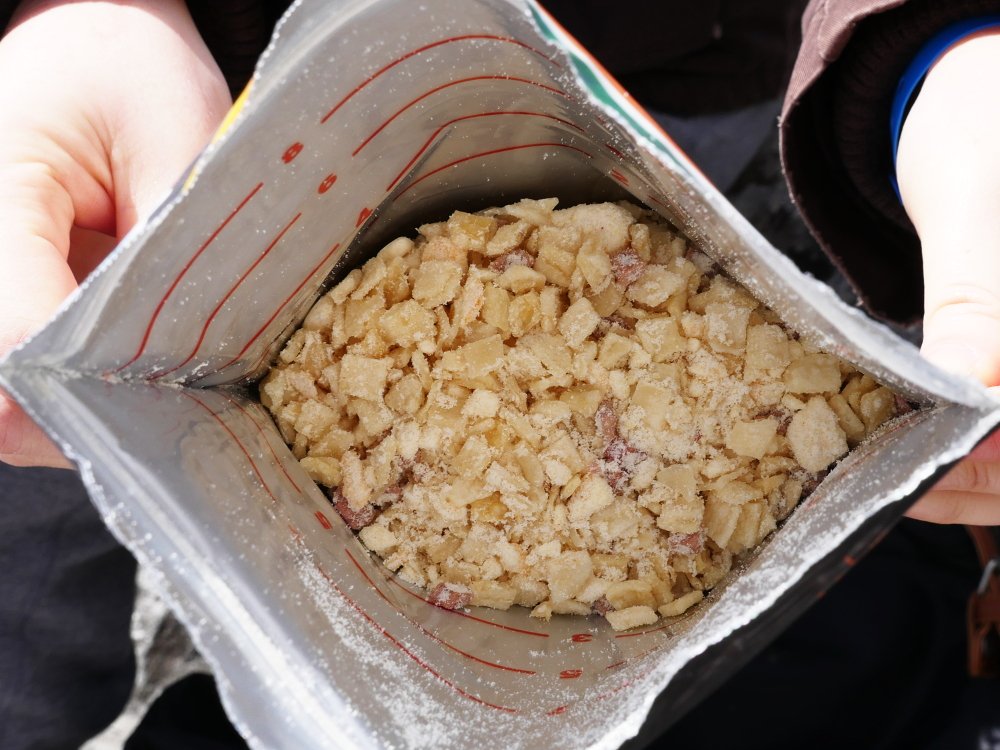How to eat during a bivouac?
During your outings, whether for one night or several days, a meal is an essential and essential moment in order to fully enjoy your excursion. In this regard, it is important not to neglect the volume as well as the weight that your rations can represent in your bag. The congestion associated with your meals will vary depending on the duration of your outing, which is why it is essential to anticipate it.
There is now an alternative, making it possible to overcome too much space while ensuring quality nutrition: dehydrated food.
Freeze-drying is a method of preserving food which today gives the best results among all preservation solutions both in terms of taste and appearance of food, shelf life, nutritional values, weight, volume and method of preparation.
Freeze-dried dishes are easily stored, especially with their small format as well as their long shelf life. The choice of recipes is vast and it is not limited to hot meals. Indeed, there are recipes for desserts, breakfasts, fruits and cheeses. The diversity of both freeze-dried and dehydrated recipes makes it possible to offer selections that will suit people prone to food intolerances, while allowing everyone’s taste buds to be delighted.

How to differentiate the types of food to rehydrate?
100% freeze-dried
To obtain a freeze-dried dish, it is first necessary to to cook this dish. Once this step is completed and the ingredients have simmered, the producer freezes this preparation using a lyophilisateur (down to -40 ° C). Secondly, it is necessary toremove the air present in the device, before passing the freeze-dryer from a temperature of -40 to 0 ° C. In this case, the sublimation is used. This technique allows the water present in the food to be transformed from solid to gaseous state without necessarily going through the liquid state.
Freeze-dried food has several advantages:
- A higher kcal rate for a given serving.
- Possibility of rehydrate in cold waterPlease note that this method requires a longer rehydration time.
- Lifetime extended products, from 3 to 8 years for sachets and up to 25 years for boxes.
- No additives or preservatives (apart from a few exceptions for egg-based recipes)
The only notable drawback about freeze drying is mainly the price. Indeed, it is higher than for dehydrated dishes or for those which combine the two methods.
In addition, freeze-drying ensures conservation of more than 95% of the nutritional values of the product, compared to only 60% for a dehydrated meal.
100% dehydrated
Unlike freeze-drying, dehydration involves preserving food by a heat drying. The elimination of water allows an increased conservation, but also to reduce the weight of the food. The use of this process consumes much less energy than the previous one, however it has a direct impact on the taste and nutritional quality of the product (dehydration can lead to up to 10 to 50% loss).
These types of dishes have a shelf life of 2 years after the date of manufacture, but the process is much less expensive than freeze-dried dishes.
Unlike freeze-dried meals, dehydrated meals must be must be rehydrated with hot water.
The mixture of freeze-dried and dehydrated
Finally, there is a third process which put the two together previous ones. This method makes it possible to cook larger productions, by dehydrating or freeze-drying only one ingredient in large quantities, so that manufacturing costs are reduced. The less fragile foods can be dehydrated, such as starches and can be combined with freeze-dried products, such as meat, which will retain their quality.
Of course, these meals are rehydrated with hot water and can sometimes lack of tastes since they did not simmer together during their initial preparation.

How to use a meal to rehydrate?
The use of a meal to be rehydrated requires thewater use, usually hot, but can also be cold if this dish is freeze-dried. To do this, use your stove before filling the bag up to the limit indicated. All you have to do is wait while your meal rehydrates. Some brands, such as Tactical Foodpack also offer to heat the preparation directly inside the container by placing it over the fire.
The positive aspects of meals to be rehydrated:
- Limited crockery, your meal can be made directly in its original packaging, which allows a gain in volume, because you do not need to bring a fork, knife or plate, a simple spoon is sufficient.
- A varied choice of meals with very low weight and volume.
- From balanced dishes with taste, all with a quick and convenient preparation.
The only negative point that can be noted with meals to rehydrate remains access to water. Indeed, if the installation of your bivouac is not near a water point or if you do not have enough left at the bottom of your water bottles, the consumption of this type of meal is not possible.
Be careful, however, the portions are not always sufficient in terms of energy and calories, so do not hesitate to bring supplements such as cereal bars for example.


